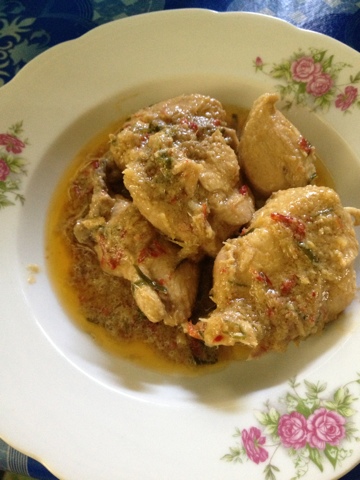Today I want to share my mom's no 1 recipe: Pecal. Pecal is originally a Javanese food. It's like gado-gado with a slightly different taste. This is the food people searching for at my house during hari raya. I asked mak why she serves pecal on hari raya because it is not a common food during the occasion. She said this culture has been passed from my grandmother which is originally Indonesian. From all her 6 siblings, only my mom inherited the recipe. Hence, my uncles, aunties and relatives came to my house to have it.
Mak always asked us, her daughters to learn how to make pecal. But then we always said mak make it better especially in blended the ingredients for the sauce. We always shouted from kitchen whenever the sauce has finished and mak will gets angry because she was busy in the living room entertaining guests. So, this year mak has decided that she wants me to make the everything from A to Z. Luckily, nobody complained. :) Here, I write it down for my future reference.
The peanut sauce
Tapioca leaves
Mung beans sprouts
Cucumber
Noodles
Ingredients (for sauce):
~ Dried chillies*
~ Onion*
~ Garlic*
~ Shrimp paste*
~ Peanut - deep fried, blend not too fine
~ Tamarind paste juice
~ Kencur/cekur - finely pound
~ Salt, sugar, msg
Methods:
1. Finely blend all the * ingredients. In a pan, heat some oil and cook the blended ingredients in a medium heat until it well cooked (dark red colour). This is the base of the sauce. Mak made this in a bunch to make the process of making sauce easier. Everyday heat it 2 times in morning and night and it can be keep for 3-4 days.
2. To make the sauce, first mix well the chilli mixture with sugar, salt and msg. Add in peanut, kencur, some tamarind juice and water. Blend everything well not too thick. Adjust the ingredients to your liking. According to mak, put kencur more to get nice aroma. Sauce has to be make in a small quantity to get a fresh taste. If make in a large amount, make sure heat it frequently.
Other ingredients:
~ Tapioca leaves, boil until soft with some salt and kapur makan to have a nice green color.
~ Mung beans sprouts, this is another speciality in my moms pecal because she made this by herself.
~ Noodles
~ Cucumber
~ Unripe papaya
~ Fried tofu
Actually you can put anything you like as the ingredient to eat pecal. Whatever convenient for you to find or whatever you like.
This is photo of last year hari raya
To date we have finished, 15kg of peanut, 20 bags of noodles, 5kg of mung beans. Tapioca trees around my house and neighbourhood also has been "kachal" (bald). Mak has stopped making pecal on 8th day of hari raya and she will make it again this weekend. Neighbours and families also being generous by giving the ingredients for pecal. Some of them gave mak some money because they knowhow complicated the process of making pecal. Alhamdulillah. Khoda ro shokr that with pecal our family's ties getting stronger. I just hope that this recipe won't extinct. Me myself will keep the culture forever. And I am proud of it.
Taa daafe baad...salamati ba hameghi va khodanegahdar...





























